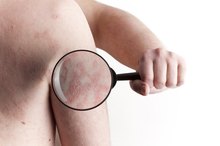What does fact checked mean?
At Healthfully, we strive to deliver objective content that is accurate and up-to-date. Our team periodically reviews articles in order to ensure content quality. The sources cited below consist of evidence from peer-reviewed journals, prominent medical organizations, academic associations, and government data.
The information contained on this site is for informational purposes only, and should not be used as a substitute for the advice of a professional health care provider. Please check with the appropriate physician regarding health questions and concerns. Although we strive to deliver accurate and up-to-date information, no guarantee to that effect is made.
Itchy Skin From Sun Exposure
Ultraviolet light from the sun may lead to conditions that make your skin itchy, especially if you are photosensitive. According to Skincancer.org, itchy skin that results from photosensitivity commonly affects your face, outer arms and upper chest. Visit your doctor any time unexplained changes happen to your skin or if your condition gets worse.
Conditions
Intellihealth.com suggests that polymorphus light eruption, or PMLE, is the most sun-related skin problem that doctors see besides sunburn. You may experience a photoallergic eruption when chemicals that you apply to your skin react with sunlight and your skin. Solar urticaria is an allergic reaction that occurs with sun exposure and produces hives. Sun exposure can also cause dry skin that may itch 2.
- Intellihealth.com suggests that polymorphus light eruption, or PMLE, is the most sun-related skin problem that doctors see besides sunburn.
- Solar urticaria is an allergic reaction that occurs with sun exposure and produces hives.
Risk Factors and Causes
How to Get Rid of Heat Rash Scars
Learn More
You may be more likely to experience PMLE if you are a woman under 30 years old. Your risk for PMLE is higher if you have light skin and live in Northern regions further from the equator. PMLE may be hereditary, so your risk for this condition increases if you have a family history of the disorder. Photoallergic eruptions are triggered by sunlight reacting with chemicals that may exist in sunscreen, fragrances, cosmetics, antibiotic ointments or oral prescription drugs. Antibiotics, phenothiazines, diuretics, oral contraceptives, ibuprofen and naproxen may lead to photoallergic eruptions. Solar urticaria is a rare condition that occurs more often in women under 30.
- You may be more likely to experience PMLE if you are a woman under 30 years old.
- Your risk for PMLE is higher if you have light skin and live in Northern regions further from the equator.
Symptoms
Itchy skin that develops with PMLE may occur hours after you are exposed to sunlight and last a week or more. The itchy skin may have small bumps, redness, blistering and burning. You may also experience a headache, chills and nausea with PMLE. Photoallergic eruptions may cause an itchy red rash or tiny blisters. These eruptions may not form until one or two days after exposure to sunlight and may spread to areas of your body that were not exposed to the sun. Solar urticaria produces welts known as hives on the skin after sun exposure.
- Itchy skin that develops with PMLE may occur hours after you are exposed to sunlight and last a week or more.
- These eruptions may not form until one or two days after exposure to sunlight and may spread to areas of your body that were not exposed to the sun.
Treatment
Cornstarch Home Remedy for Hives Itching
Learn More
Over-the-counter anti-inflammatory creams can soothe your skin and reduce itching and discomfort that occur with itchy skin from sun exposure. Oral anti-inflammatory drugs such as aspirin and ibuprofen can help reduce redness and soreness that may occur with these conditions. Soak a bath towel with cold water and apply it to your itchy skin or take a cool bath. Do not pop any blisters that may develop on your skin. Cover any blisters lightly with gauze. You can prevent itchy dry skin caused by sun exposure by gently patting your skin dry and applying moisturizer after showering 2. You can treat hives with oral antihistamines. MedlinePlus.com recommends diphenhydramine for hives.
- Over-the-counter anti-inflammatory creams can soothe your skin and reduce itching and discomfort that occur with itchy skin from sun exposure.
Prevention
Use sunscreen that is 15 SPF or greater that protects you from both UV-A and UV-B rays. Use sunscreen products that are SPF 20 or greater on your lips and face and are especially formulated for these areas. You can prevent eruptions and itchy dry skin by limiting the time you spend in the sun, especially between 10 a.m. and 3 p.m. in the United States 2. Try to keep your skin covered with clothing when you are in the sun.
- Use sunscreen that is 15 SPF or greater that protects you from both UV-A and UV-B rays.
Related Articles
References
- Intelihealth: Sun Allergy
- Mayo Clinic: Dry Skin
- Mayo Clinic: PMLE
- Skin Cancer Foundation: Sun Burn
- Medline Plus: Hives
- Lehmann P, Schwarz T. Photodermatoses: diagnosis and treatment. Dtsch Arztebl Int. 2011;108(9):135-41.
- Cleveland Clinic. Sun allergy. Reviewed January 16, 2018.
- Harvard Medical School. Sun allergy (photosensitivity). Harvard Health Publishing. October 2018.
- National Health Service. Polymorphic light eruption. Reviewed May 24, 2018.
- MedlinePlus. Polymorphous light eruptions. Reviewed April 16, 2019.
- Badri T, Schlessinger J. Solar urticaria. StatPearls (Internet). Updated April 11, 2019.
- Ngan V. Cholinergic urticaria. DermNet NZ. 2006.
- London S. Expert offers insight on photocontact dermatitis. November 22, 2013.
Writer Bio
Miguel Cavazos is a photographer and fitness trainer in Los Angeles who began writing in 2006. He has contributed health, fitness and nutrition articles to various online publications, previously editing stand-up comedy and writing script coverage as a celebrity assistant. Cavazos holds a Bachelor of Arts in philosophy and political science from Texas Christian University.








